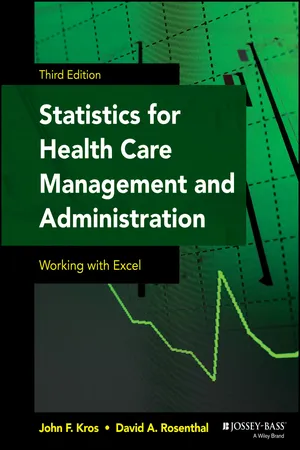
Statistics for Health Care Management and Administration
Working with Excel
- English
- ePUB (mobile friendly)
- Available on iOS & Android
Statistics for Health Care Management and Administration
Working with Excel
About this book
Statistics for Health Care Management and Administration is a unique and invaluable resource for students of health care administration and public health. The book introduces students to statistics within the context of health care, focusing on the major data and analysis techniques used in the field. All hands-on instruction makes use of Excel, the most common spreadsheet software that is ubiquitous in the workplace. This new third edition has been completely retooled, with new content on proportions, ANOVA, linear regression, chi-squares, and more, Step-by-step instructions in the latest version of Excel and numerous annotated screen shots make examples easy to follow and understand.
Familiarity with statistical methods is essential for health services professionals and researchers, who must understand how to acquire, handle, and analyze data. This book not only helps students develop the necessary data analysis skills, but it also boosts familiarity with important software that employers will be looking for.
- Learn the basics of statistics in the context of Excel
- Understand how to acquire data and display it for analysis
- Master various tests including probability, regression, and more
- Turn test results into usable information with proper analysis
Statistics for Health Care Management and Administration gets students off to a great start by introducing statistics in the workplace context from the very beginning.
Frequently asked questions
- Essential is ideal for learners and professionals who enjoy exploring a wide range of subjects. Access the Essential Library with 800,000+ trusted titles and best-sellers across business, personal growth, and the humanities. Includes unlimited reading time and Standard Read Aloud voice.
- Complete: Perfect for advanced learners and researchers needing full, unrestricted access. Unlock 1.4M+ books across hundreds of subjects, including academic and specialized titles. The Complete Plan also includes advanced features like Premium Read Aloud and Research Assistant.
Please note we cannot support devices running on iOS 13 and Android 7 or earlier. Learn more about using the app.
Information
Part 1
- Statistics and Excel
- Excel as a Statistical Tool
- Data Acquisition: Sampling and Data Preparation
- Data Display: Descriptive Presentation, Excel Graphing Capability
- Basic Concepts of Probability
- Measures of Central Tendency and Dispersion: Data Distributions
Chapter 1
Statistics and Excel
Learning Objectives
- Understand how this book differs from other statistics texts
- Understand how knowledge of statistics may be beneficial to health policy or health administration professionals
- Understand the “big picture” with regard to the use of statistics for health policy and administration
- Understand the definitions of the following terms:
- Populations and samples
- Random and nonrandom samples
- Types of random samples
- Variables, independent and dependent
- Identify the five separate statistical tests: chi-square test, the t test, analysis of variance (ANOVA), regression analysis, and Logit
1.1 How This Book Differs from Other Statistics Texts
1.2 Statistical Applications in Health Policy and Health Administration
Table of contents
- Cover
- Title Page
- Copyright
- Table of Contents
- Dedication
- Preface
- Acknowledgments
- The Authors
- Part 1
- Part 2
- Appendix A: Multiple Regression and Matrices
- References
- Glossary
- Index
- End User License Agreement